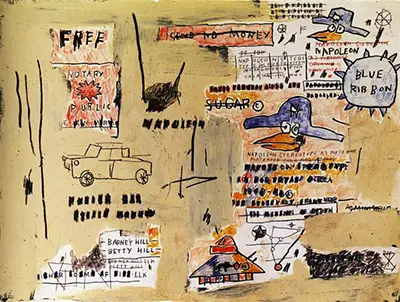We find a wealth of detail, and a number of vehicles placed upon a bland background which may have been cardboard, or simply painted in that tone of light brown. First we spot a car, with lettering below. Basquiat would regularly include cars within his artworks, sometimes after having crashed. We then find an abstract depiction of some sort of tank, delivered in a manner akin to a child's art, which was common within 20th century art. Many more references are then added to the right hand side, including Blue Ribbon, several mentions of Napoleon and further unrecognisable shapes and lines. Basquiat studied European art and history in his early years and would discuss different empires from that region within his paintings, sometimes describing how they still had influence on his life in the US, all these years later.
This graffiti painter would help to change perceptions within the art industry by showing the talents of people from alternative backgrounds who traditionally would not have been as involved in this industry. The same can also be said for women too, who are now much more present than previously would have been the case. This is all part of a more progressive society in which talent should be the overriding factor in determining how successful anyone can manage to be. Today, things have improved in that regard and much of the change was due to artists such as this helping to change perceptions both within the industry itself, but also within the general public who would then start to be exposed to new ideas and conversations that previously they simply had not come across, nor taken time to consider. This change continues onwards and provides an opportunity for more people to make the most of their abilities.
Basquiat left behind several hundred artworks, featuring a variety of drawings and paintings within a fairly consistent use of imagery and graffiti art. Some of the highlights included Riding with Death, Horn Players and Basquiat's Dinosaur but there are now more comprehensive publications around his career which better capture a wider variety of his work. He would regularly combine different mediums within his work and perhaps the use of oil pens were his most frequent choice. Modern art in the latter half of the 20th century was fill to the brim with combinations in this way, with the days of artists restricting themselves to just oils or egg tempera being consigned to the past in most cases. One can also see similar in sculpture, too, with modern sculpture being much more varied in the tools and techniques used as compared to the likes of Michelangelo who would stick to a single block of marble from which to chisel their latest masterpiece.


